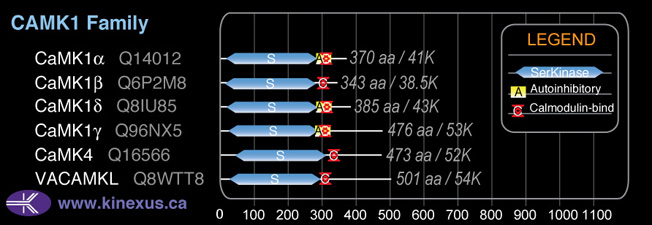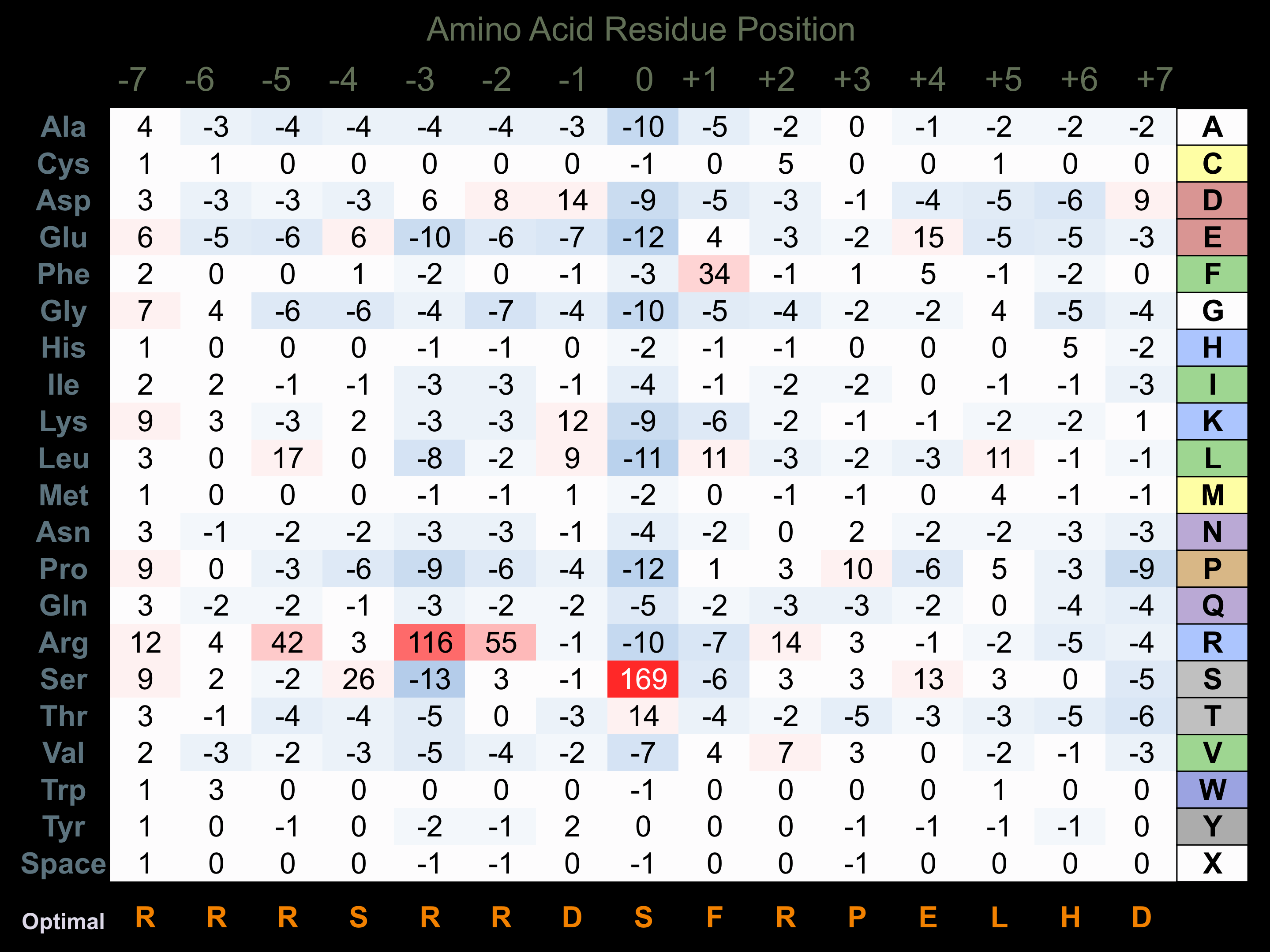Nomenclature
Short Name:
VACAMKL
Full Name:
CaM kinase-like vesicle-associated
Alias:
- CAMKV
- MGC8407
Classification
Type:
Protein-serine/threonine kinase
Group:
CAMK
Family:
CAMK-Unique
SubFamily:
NA
Structure
Mol. Mass (Da):
54,354
# Amino Acids:
501
# mRNA Isoforms:
3
mRNA Isoforms:
54,354 Da (501 AA; Q8NCB2); 51,687 Da (470 AA; Q8NCB2-3); 51,209 Da (473 AA; Q8NCB2-2)
4D Structure:
Interacts with calmodulin, in the presence of calcium
1D Structure:
Subfamily Alignment

Domain Distribution:
| Start | End | Domain |
|---|---|---|
| 24 | 286 | Pkinase |
| 301 | 316 | CaM_binding |
Post-translation Modifications
For detailed information on phosphorylation of this kinase go to PhosphoNET
Acetylated:
K48, K53, K62.
Serine phosphorylated:
S18, S376, S495.
Tyrosine phosphorylated:
Y491.
Ubiquitinated:
K65.
Distribution
Based on gene microarray analysis from the NCBI
Human Tissue Distribution
% Max Expression:
Mean Expression:
Number of Samples:
Standard Deviation:
% Max Expression:
Mean Expression:
Number of Samples:
Standard Deviation:
 56
56
695
16
935
 6
6
68
8
73
 4
4
44
9
70
 76
76
934
54
978
 29
29
363
14
344
 2
2
25
37
14
 1.4
1.4
17
15
16
 100
100
1233
27
3038
 14
14
168
10
149
 5
5
64
43
69
 4
4
52
22
74
 59
59
723
73
650
 3
3
43
22
34
 5
5
59
6
65
 5
5
65
9
52
 4
4
49
7
51
 35
35
430
87
3309
 5
5
57
16
76
 7
7
83
47
57
 23
23
278
56
304
 10
10
120
18
124
 3
3
33
20
32
 3
3
42
12
54
 4
4
47
16
61
 3
3
42
18
44
 62
62
770
33
2164
 3
3
38
25
38
 4
4
45
16
62
 3
3
36
16
47
 39
39
478
14
221
 36
36
441
18
303
 50
50
611
21
651
 0.2
0.2
2
17
2
 67
67
831
26
717
 21
21
259
22
121
Evolution
Species Conservation
PhosphoNET % Identity:
PhosphoNET % Similarity:
Homologene %
Identity:
PhosphoNET % Identity:
PhosphoNET % Similarity:
Homologene %
Identity:
 100
100
100
100 99.8
99.8
99.8
100 98.8
98.8
98.8
- -
-
-
93 -
-
-
- 94.6
94.6
95.2
94 -
-
-
- 91.8
91.8
93.3
93 91.8
91.8
93.4
92 -
-
-
- 44.1
44.1
59
- 24.9
24.9
42.5
87 65.4
65.4
72
89 66.2
66.2
77
88.5 63.8
63.8
71.8
- -
-
-
- -
-
-
- -
-
-
- -
-
-
- -
-
-
- -
-
-
- -
-
-
- -
-
-
- -
-
-
- -
-
-
-
For a wider analysis go to PhosphoNET Evolution in PhosphoNET
Regulation
Activation:
NA
Inhibition:
NA
Synthesis:
NA
Degradation:
NA
Protein Kinase Specificity
Matrix of observed frequency (%) of amino acids in aligned protein substrate phosphosites

Matrix Type:
Predicted from the application of the Kinexus Kinase Substrate Predictor Version 2.0 algorithm, which was trained with over 10,000 kinase-protein substrate pairs and 8,000 kinase-peptide substrate pairs.
Domain #:
1
Disease Linkage
Gene Expression in Cancers:
TranscriptoNET (www.transcriptonet.ca) analysis with mRNA expression data retrieved from the National Center for Biotechnology Information's Gene Expression Omnibus (GEO) database, which was normalized against 60 abundantly and commonly found proteins, indicated altered expression for this protein kinase as shown here as the percent change from normal tissue controls (%CFC) as supported with the Student T-test in the following types of human cancers: Bladder carcinomas (%CFC= -57, p<0.0007); Cervical cancer (%CFC= +54, p<0.0001); Pituitary adenomas (ACTH-secreting) (%CFC= +103); and Pituitary adenomas (aldosterone-secreting) (%CFC= +123, p<0.014). The COSMIC website notes an up-regulated expression score for VACAMKL in diverse human cancers of 345, which is 0.8-fold of the average score of 462 for the human protein kinases. The down-regulated expression score of 0 for this protein kinase in human cancers was 100% lower than the average score of 60 for the human protein kinases.
Mutagenesis Experiments:
Insertional mutagenesis studies in mice have not yet revealed a role for this protein kinase in mouse cancer oncogenesis.
Mutation Rate in All Cancers:
Percent mutation rates per 100 amino acids length in human cancers: 0.07 % in 25004 diverse cancer specimens. This rate is only -12 % lower than the average rate of 0.075 % calculated for human protein kinases in general.
Mutation Rate in Specific Cancers:
Highest percent mutation rates per 100 amino acids length in human cancers: 0.55 % in 864 skin cancers tested; 0.37 % in 1229 large intestine cancers tested; 0.3 % in 603 endometrium cancers tested; 0.29 % in 555 stomach cancers tested; 0.17 % in 238 bone cancers tested; 0.07 % in 807 ovary cancers tested; 0.07 % in 558 thyroid cancers tested; 0.04 % in 548 urinary tract cancers tested; 0.04 % in 1512 liver cancers tested; 0.03 % in 710 oesophagus cancers tested; 0.03 % in 1289 breast cancers tested; 0.02 % in 942 upper aerodigestive tract cancers tested; 0.02 % in 2052 central nervous system cancers tested; 0.02 % in 2009 haematopoietic and lymphoid cancers tested; 0.02 % in 1609 lung cancers tested; 0.01 % in 1437 pancreas cancers tested; 0 % in 1276 kidney cancers tested.
Frequency of Mutated Sites:
Most frequent mutations with the number of reports indicated in brackets: G182R (3); G182R (1); G182V (1).
Comments:
Only 1 insertion, and no deletions or complex mutations are noted in COSMIC website.

